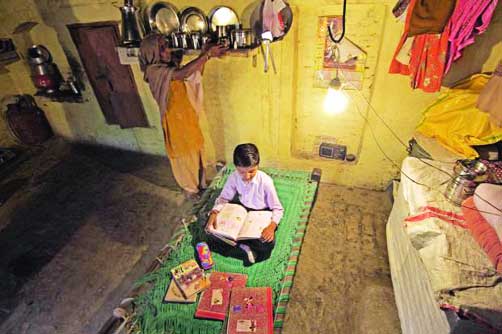The figures from Jammu & Kashmir’s electricity department reveal that the power system is up to the mark. However, on the other hand, the ground reality is way different from what they show, says Basharat Akhtar
A special attention was given to various ambitious plans of the Modi government in this year’s budget, which also included the Saubhagya scheme. The scheme incorporates electricity connection to all households in rural as well as urban areas by the year 2022. The scheme was launched back in 2017 and the initial deadline was December 2018. In February, Jammu & Kashmir bagged the Saubhagya Excellence Award for being the first state to achieve successful implementation of the scheme.
On October 17, 2018, Greater Kashmir, a Kashmir based English daily, published a report quoting Commissioner Secretary Power Development Department (PDD), Hardesh Kumar that 100 per cent electrification had been completed in six districts of Srinagar, Badgam, Pulwama, Jammu, Samba, and Kathua whereas in 16 other districts, the work is in the final phase. At the same time, he also informed that infrastructure had been built to connect 102 border villages of the state to provide electricity connection. By May 31, 6,337 villages of Jammu and Kashmir had received the connection under the Sahaj Bijli Har Ghar Yojana (Saubhagya), which is considered as Prime Minister Narendra Modi’s dream project. Around Rs 133.42 crores have been approved out of which Rs 53.24 crores have already been released. Also, Rs 435.13 crores have been incurred from the additional amount of Rs 875.03 crores. According to Deendayal Upadhyaya Gram Jyoti Yojana, DDUGJY and Saubhagya, 15,10,271 out of a total of 18,72,195 households have been electrified. Electrical connections have been provided to 8,861 additional households since February 1. The figures from Jammu & Kashmir’s electricity department reveal that the power system is up to the mark and the process of electrifying is being implemented at a rapid pace. But on the other hand, if we look at the ground reality, the difference between what is being claimed and the reality is poles apart.
Even after the deadline had passed last year, the aim has not been achieved. However, since the launch of the Subhagya scheme, there has been great improvement in the situation but there are many such areas where electricity wires and pillars are yet to reach. From a geographical perspective, most areas of the valley are located on mountainous regions, which are covered with snow for more than half of the year. In such areas, uninterrupted supply of electricity is the biggest challenge. Several times, the snow storms badly affects the power system. Besides that, the electric system is disrupted in many areas because wooden poles have been used to support the electric cables, which often crumble under heavy thunderstorm and rain. Many a time, there have been incidents when the electricity current that runs through the broken poles has proved fatal for the local residents.
The problems do not end here. To meet high electricity demands, the power supply system is modified, which would then lead to low voltage and in turn creates trouble for the villagers. Ladoran, a village located on the North West Hills, which is 10 km away from Kupwara, the district headquarter, is also a victim of power mismanagement. The village has a population of 3,200 people. But even today, the electricity in the village is negligible. Villagers have to make alternative arrangements even when the bulb is lit due to low voltage. It was a challenging task to transport electric wires and poles to the mountainous village, but they were installed successfully. However, the continued issue with low voltage of electricity in the village has raised questions about the success of the state electricity department. Poor electricity is affecting the health of the villagers as well the students whose studies are constantly being interrupted.
A local student studying in tenth class, Dilshada Bano, says, “Even though there is electricity, we are not able to make a good use of it due to such low voltage. The students of the class are unable to complete their homework on time because of which the teachers scold them. Also, the future of the students preparing for competitive exam looks grim.” This is the major reason why so many students are giving up on their studies gradually. Although the state electricity department has spent millions in delivering electrical equipment to the village, but due to high demand, the low-megawatt transformers installed could not solve the problem. In a situation like this, the availability of electricity is considered as equivalent to none. Due to high costs involved with solar power, the option is not available to the villagers.
In this regard, village Sarpanch, Ghulam Mohiuddin Vani, also considers the electricity complaints of people completely valid. He says that in relation to low voltage, he has raised their concerns to the high officials of the department many times but nothing has happened except for their assurance. Sarpanch says, “The village needs at least 10 MW whereas only 6 MW transformers has been installed by the department due to which excessive load on the transformer increases and results in low voltage problems. The issue can easily be addressed by installing high MW transformers.” Apart from this, the difficulty that the villagers face can be fixed by timely repairs of electrical wires and by replacing the wooden poles with the proper ones. Though the department has nominated this village under the DDUGJY last year, the villagers are yet to receive its benefits. Let’s hope that the flame of education does not burn one day.
Writer : Basharat Akhtar
Courtesy: Viva City








 OpinionExpress.In
OpinionExpress.In















Comments (0)